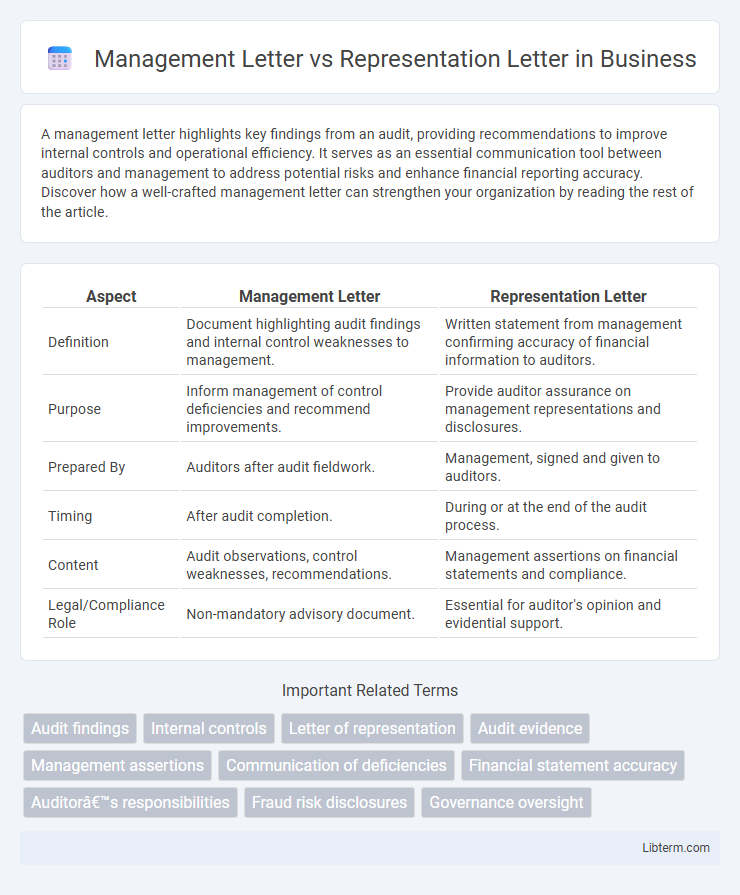A management letter highlights key findings from an audit, providing recommendations to improve internal controls and operational efficiency. It serves as an essential communication tool between auditors and management to address potential risks and enhance financial reporting accuracy. Discover how a well-crafted management letter can strengthen your organization by reading the rest of the article.
Table of Comparison
| Aspect | Management Letter | Representation Letter |
|---|---|---|
| Definition | Document highlighting audit findings and internal control weaknesses to management. | Written statement from management confirming accuracy of financial information to auditors. |
| Purpose | Inform management of control deficiencies and recommend improvements. | Provide auditor assurance on management representations and disclosures. |
| Prepared By | Auditors after audit fieldwork. | Management, signed and given to auditors. |
| Timing | After audit completion. | During or at the end of the audit process. |
| Content | Audit observations, control weaknesses, recommendations. | Management assertions on financial statements and compliance. |
| Legal/Compliance Role | Non-mandatory advisory document. | Essential for auditor's opinion and evidential support. |
Introduction to Management Letter and Representation Letter
Management letters provide auditors' observations on a company's internal controls and operational efficiency, highlighting areas for improvement discovered during the audit process. Representation letters are formal written statements from management confirming the accuracy and completeness of the financial information provided to auditors. Both letters serve critical roles in the audit cycle, supporting transparency and accountability in financial reporting.
Definition of Management Letter
A Management Letter is a formal document prepared by auditors that outlines internal control weaknesses and recommendations for improvement identified during the audit process. It serves as a communication tool directed to an organization's management, aiming to enhance operational efficiency and compliance. Unlike a Representation Letter, which confirms management's assertions, the Management Letter provides constructive feedback to strengthen governance and risk management.
Definition of Representation Letter
A Representation Letter is a formal document provided by management to auditors, confirming the accuracy and completeness of the financial statements and disclosures. It serves as written assurance that all relevant information has been disclosed and that management acknowledges responsibility for the financial reporting process. The Management Letter, in contrast, contains auditors' observations and recommendations on internal controls and operational improvements identified during the audit.
Key Purposes of Management Letter
The Management Letter primarily addresses internal control weaknesses and operational inefficiencies identified during an audit to provide management with actionable recommendations for improvement. It serves as a communication tool that highlights risks and suggests enhancements in financial reporting processes and governance practices. Unlike the Representation Letter, which confirms management's assertions about financial statements, the Management Letter focuses on strengthening organizational controls and compliance.
Key Purposes of Representation Letter
The key purpose of a representation letter is to provide written confirmation from management to auditors regarding the accuracy and completeness of financial statements and disclosures. It serves as evidence that management acknowledges responsibility for the information presented and has disclosed all relevant matters affecting the audit. This letter is crucial for auditors to form an opinion and ensure the integrity of the financial reporting process.
Main Differences Between Management Letter and Representation Letter
The main differences between a Management Letter and a Representation Letter lie in their purpose and origin: a Management Letter is issued by auditors to communicate internal control weaknesses and recommendations to management, while a Representation Letter is a written statement from management to auditors asserting the accuracy and completeness of financial information. Management Letters focus on improving organizational processes, whereas Representation Letters serve as evidence supporting the financial statements' reliability. Furthermore, Management Letters are advisory and non-binding, whereas Representation Letters legally bind management to their assertions during an audit.
Content Structure Comparison
The Management Letter typically highlights internal control weaknesses, operational deficiencies, and recommendations for improvement, structured around audit findings and management responses. The Representation Letter, however, is a formal written statement from management confirming the accuracy and completeness of the financial information provided to auditors, organized as specific assertions regarding financial statement items. While the Management Letter is narrative-focused and advisory, the Representation Letter is concise, factual, and legally significant in confirming management's accountability.
Importance in the Audit Process
The Management Letter plays a crucial role in the audit process by highlighting internal control weaknesses and providing recommendations for improvement, which enhances organizational governance and risk management. The Representation Letter is essential as it contains written assertions from management confirming the accuracy and completeness of financial statement information, thereby supporting auditor reliance on the evidence obtained. Both letters collectively ensure transparency and accountability, reinforcing the integrity and effectiveness of the audit.
Common Misconceptions
Management letters often get confused with representation letters, but their purposes and contents differ significantly. Management letters provide auditors with insights into internal controls and recommendations for improvement, while representation letters are formal written statements from management affirming the accuracy and completeness of financial information. A common misconception is treating the management letter as a management declaration, whereas it is primarily an auditor's communication; similarly, representation letters should not be mistaken for audit evidence but rather serve to confirm management's assertions.
Conclusion and Best Practices
Management letters typically conclude with recommendations for improving internal controls and operational efficiency, serving as a communication tool between auditors and management. Representation letters are signed by management to confirm the accuracy and completeness of information provided during an audit, ensuring auditor reliance on management assertions. Best practices include thorough review and timely response to management letter findings, coupled with clear, honest disclosures in representation letters to foster transparency and support audit integrity.
Management Letter Infographic

 libterm.com
libterm.com